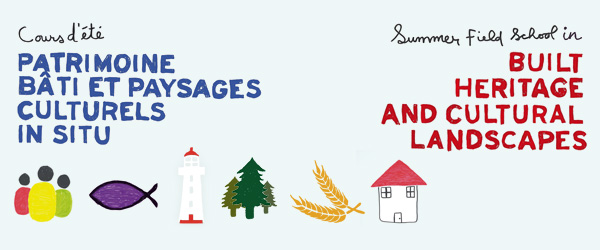
Summer Field School
A three-credit course that provides hands-on training to future professionals in the study, appreciation and preservation of regional built heritage and cultural landscapes.
During the three-week field school participants experience the process of studying cultural landscapes in-situ. They develop their abilities to record, interpret and propose innovative historic preservation strategies. Grounded in a pedagogy that combines empirical research (e.g. field recording, oral history, analysis of primary source documents), action research (e.g. public participation in course activities, informal exchanges), and creation research (e.g. design), also introduces conventional and avant-garde field recording techniques such as photogrammetry and GPS (depending on the interests of students and as time permits).
Working closely with faculty and other professionals, participants will first document the case study site as it exists today, paying close attention to geographical, architectural, social, economic, cultural and religious dimensions. After meeting with local experts and citizens and analysing archival documents (plans, maps, newspapers, photographs, paintings, etc) and pertinent material culture (statuary, secondary buildings, field patterns, crops, etc.), they will then interpret these places in their socio-cultural, economic, and historical context using interpretive frameworks from such disciplines as cultural geography, the history of architecture, social history, and ethnography. Finally, participants will engage local stakeholders, government authorities, representatives of heritage groups and cultural organisations and community members in discussions concerning the future of their built heritage in relation to the development of their community and work with them to envision appropriate historic preservation strategies that are in keeping with the needs and values of the population.
All course activities take place on-site in the Gaspe Peninsula. The seminars, field recording, in-class or studio time, and participative design workshops and exhibition, put participants in contact with local citizens, government officials, and professionals (architects, urban planners, historians, geographers), as well as with instructors from diverse institutions renown for their work in vernacular architecture and cultural landscape studies.
Cultural landscapes and built heritage of the Gaspe
Combined works of nature and humankind, they express a long and intimate relationship between peoples and their natural environment (UNESCO). This field school takes a cultural landscape approach to this work, defined here not just as buildings but as the reciprocal relationships between social groups and their buildings and spaces, and how these relationships have changed over time. All modifications humans make to the environment at a given moment and in a given place speak to the ways a society structures itself. A place embodies the social and economic relationships established between members of a group as well as the cultural and religious values they hold dear. The resulting organisation of space is the sedimentation of those historically-made choices and the built forms we see today constitute a veritable archive. As John Brinckerhoff Jackson said «cultural landscapes make history visible ». Sometimes, when evidence of a particular period disappears, that history is carried instead in peoples’ heart, memory and imagination.
Reputed since the beginning of the twentieth century for its majestic natural landscapes, the Gaspe remains a region to study and comprehend through the lens of cultural landscapes. The meeting ground of Micmac, French, Basques, English, as well as Acadians, American Loyalists, Scotch, Irish and French-Canadian colonizers, its landscapes are subtly marked by modest settlements whose economy turned towards sea and forest. A string of villages and hamlets hug the coastline, evidence of a landscape shaped by human action. How can we accurately describe these settlements and their diverse component structures? What do they teach us about the successive inhabitants who lived there and the consequences of their actions? How have the civic priorities, economic decisions, and religious practices of the different cultural groups forged these places up until the present-day? How can we preserve the particularities of place while also responding to the needs of current and future generations? These are the types of questions that this course addresses.
Required readings before arrival
- Bernier, Lionel. La bataille de Forillon : roman (Montréal : Fides, 2009).
- Byrne, Denis. « Heritage as Social Action » in The Heritage Reader Graham Fairclough, Rodney Harrison, John H. Jameson Jr., John Schofield (London and New York : Routledge, 2008) : pages 149-173.
- Carter, Thomas and Elizabeth Cromley. Invitation to Vernacular Architecture (Knoxville: University of Tennessee Press, 2005).
- Chappell, Edward. Looking at Buildings (pdf. Disponible à partir du site web du cours).
- Magnaghi, Alberto. Le projet local (Sprimont, Belgique : éditions Pierre Mardaga, 2003)
- Mimeault, Mario. Gaspésie, Regions of Quebec Collection A brief history 6 (Québec : Presse de l’Université Laval, 2005)
Recommended Readings
- Bouchard, Roméo. Il y a-t-il un avenir pour nos régions. (Montréal : Les Éditions Écosociété, 2013)
- Desjardins, Marc, Yves Frenette, Jules Bélanger et al., Histoire de la Gaspésie (Québec : Institut québécois de recherche, 1999).
- Domon, Gérald, and Julie Ruiz. Paysages ruraux: Méthodes d’état des lieux at de diagnostic. (Montréal: Les Presses de l’Université de Montréal, 2015).
- Jackson, John Brinckerhoff. Discovering the vernacular landscape. (New Haven : Yale University Press, 1984).
- Meinig, Donald William and Jackson, John Brinckerhoff, eds. The Interpretation of Ordinary Landscapes: Geographical Essays (New York : Oxford University Press, 1979).
- Williams, Ron. Landscape Architecture in Canada (McGill-Queen’s University Press, 2014).
Course instructors include
- Tania Martin, coordinator
Full Professor, Université Laval School of Architecture, Quebec - Stéphanie Harnois, Professor in Geography, Cégep de la Gaspésie et des Îles, Campus de Gaspé
- Antoine L’Italien-Savard, architect, Public Works and Governement Services, Canada, Québec
- Jean-François Spain, Professor in Tourism and the Outdoors, Cégep de la Gaspésie et des Îles, Campus de Gaspé
- Nancy van Dolsen, Architectural and Landscape Historian and Adjunct Professor in Public History at North Carolina State University, Raleigh
Other guest instructors to be confirmed
